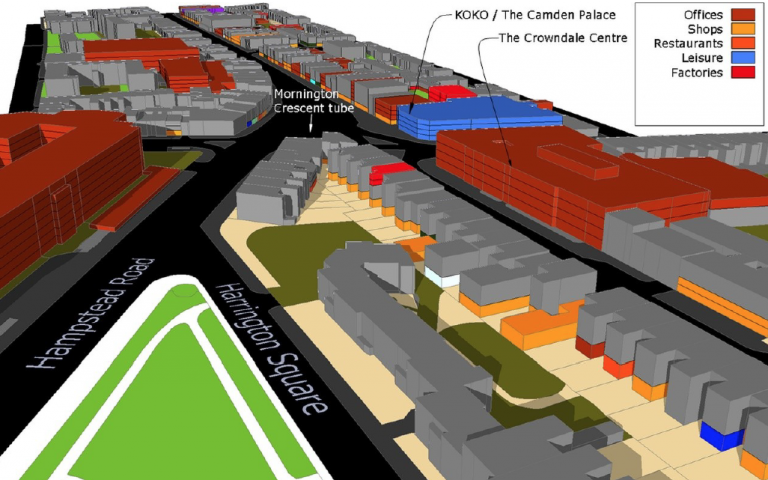Smart energy, smart buildings, smart health
11 August 2021

At a glance
- People consume large amounts of energy in buildings, which are often inefficient, both in terms of their thermal performance but also in how they are used.
- Occupant behaviour, inefficient heating and cooling systems, and a lack of synchronisation between energy demand and supply lead to imbalances in the energy system.
- The rapid emergence of machine learning and big data in the built environment provides opportunities to reduce these inefficiencies and CO2 emissions.
- If implemented correctly, these technologies have the potential to reduce energy consumption and better balance energy demand and supply as variable renewable energy grows. They also have the potential to provide healthier indoor environments.
What is the problem?
Buildings and building construction account for nearly 40% of energy-related CO2 emissions worldwide [1]. Building and construction sector emissions have risen by nearly 1% per year since 2010. The energy intensity of buildings (energy use per square metre (m2)) needs to be substantially reduced by 2030 to contribute to meeting the targets of the Paris climate agreement. High emissions from the building sector occur because of low levels of energy efficiency as well as wasteful occupant behaviours.
What are the key characteristics of the problem?
Globally, emissions from buildings and construction are growing and reached an all-time high in 2019 of around 10 GtCO2. As yet, energy efficiency improvements and other technological developments have not been enough to offset increases in emissions due to growth in the sector.
Occupants’ choices and behaviours play a key role in how buildings and technologies within them are used, and energy consumed. Certain behaviours can lead to increased energy demand such as opening windows when heating/cooling systems are on or forgetting to switch off appliances (e.g. lights) or heating/cooling systems when they are not in use. This can result in a substantial waste of energy from homes and commercial buildings.
In response to the climate crisis, the majority of buildings will need to become more energy- efficient and move away from the use of fossil fuels for heating and cooling. As we aim for net zero, more efficient heating/cooling systems such as heat pumps will become more common. These systems will need to rely on sourcing electricity from a decarbonised grid powered by renewables such as wind and solar. Whilst electricity from wind and solar in particular is rapidly growing and becoming cheaper, wind and solar output varies depending on weather, time of day and season; although problems with intermittent generation can be mitigated with the use of various technologies such as battery storage. Fossil fuels are currently often used to meet demand during periods of high demand and low renewable supply. More sophisticated or ‘smart’ technologies are required to manage supply and demand so that supplementing renewable electricity with electricity from burning fossil fuels is not necessary during peak demand.
What is the solution?
Using digital technologies to help manage buildings and energy systems has huge potential for emission savings. The UN’s 2017 Global Status Report states active controls could save up to 230 EJ cumulatively to 2040. This is roughly twice the energy consumed by buildings globally in a typical year. Emissions savings go hand in hand with cost savings. The UK government estimated that a digitalised flexible energy system could reduce UK energy system costs by £30-70bn between now and 2050.
More and more data is being collected from buildings via smart meters, smart home systems and other devices while building control systems are becoming increasingly ‘smart’ through the use of artificial intelligence (AI) and machine learning (ML) techniques. AI is the umbrella term for machines capable of perception, logic and learning. ML is a subset of AI that employs algorithms to learn from data and make predictions without being explicitly programmed. Performance of these algorithms improves as they learn from more data. The exponential growth in computing power and data collection means that these fields have rapidly evolved in recent years from initial concept and science fiction to practical implementation.
ML techniques have the potential to change how humans and buildings interact. Ownership of smart thermostats has reached 13% in the United States. These devices are able to learn occupant heating and cooling preferences and schedules. This means they can help improve thermal comfort as well as reduce energy consumption from homes. Buildings can also be programmed to respond to external weather and the environment. For example, adaptive facades can be employed to allow the sun’s rays in during the heating season and keep them out during heatwaves.
Smart energy management systems elsewhere are becoming more common. Smart meters are being rolled out in many countries with around half of households now having one across Great Britain. These devices allow consumers to track their energy consumption in real time and facilitate behaviour change that reduces energy demand. Smart meter data, collected with consumer consent, linked to other relevant data is being used in the UK for scientific research via the Smart Energy Research Lab (SERL). The research being conducted using SERL data is facilitating innovation, informing government policy and helping people understand the significant changes in patterns of domestic energy consumption that will take place as home-working increases post-pandemic.
Smart meters, combined with other in-home sensors, are enabling innovation in other services, such as healthcare. For example, spotting unusual patterns of energy consumption, and thus activity (e.g. during the night), can help identify when conditions such as Alzheimer’s and dementia are worsening; and smart meters, combined with telehealth and assisted living technologies, can help patients live at home for longer rather than having to enter care homes or hospitals. Smart energy/building data could also be used to infer the energy efficiency of a home and identify the need for health-related upgrades. In the not-too-distant future doctors might prescribe a new heating system or upgraded insulation rather than drugs for a patient with respiratory conditions caused by living in a cold, damp home.
Smart energy data can be combined with geo-spatial data to build a 3-dimensional model of the building stock that provides a detailed understanding of energy performance of buildings at a city, regional or national scale. This type of model can be used by local government, for example, to better plan which areas or buildings are best for installation of different types of renewable energy (e.g. solar panels, heat pumps etc.). It has also been used to evaluate the potential for recovering waste heat from underground sources (e.g. the London Tube network) to heat buildings.

Figure 1: 3D map of an area of Camden showing different types of buildings which can be linked to energy usage
There are also huge potential benefits to utilising smart energy and building data at a system level. When thousands or millions of smart thermostats are connected to the central energy system it is possible to avoid critical peaks in demand by pre-heating (in cold regions) or pre-cooling (in hot regions) buildings ahead of a predicted peak in demand.
Smart grids would also allow electricity to be sourced from electric vehicle (EV) batteries during times of peak demand to help balance the grid (vehicle-to-grid flexibility). Dynamic pricing of energy tariffs that incentivise consumption during times of ample energy supply (from renewables) can also help reduce demand peaks and the need for back-up power. Smart active controls can respond to these price signals automatically, so the end user isn't required to monitor tariffs themselves.
What is stopping the solution being implemented?
There remain several barriers in the way of a broad roll out of smart energy technologies. Some of the most problematic issues relate to data sharing, with commercial and public sector organisations involved at the many levels of a smart grid (from national energy system down to individual devices) reluctant to share data openly in a manner that facilitates whole-system solutions. There remains a general level of public distrust in emerging smart technologies with building owners, facilities managers and householders reluctant to trust fully automated energy systems and devices in their homes or buildings. Furthermore, householders are particularly concerned about commercial organisations collecting data from smart devices in their home and using it for legal, but unwanted, purposes such as consumer profiling and direct marketing. The (cyber) security of smart energy and buildings data is also an important issue and data needs to be carefully stored and encrypted to evade hackers.
How can these barriers be removed?
Incorporating emerging technologies into buildings requires the whole relationship with the energy system to be considered. If buildings are to be truly smart, they must also be energy-efficient. Governments need to subsidise energy efficiency retrofit schemes, as well as technologies such as smart thermostats.
A lack of good quality data caused by poor data-sharing practices is a barrier that needs to be quickly overcome. While more and more data is becoming openly accessible, it is not always linked to other useful datasets. In order for smart buildings to be well integrated with the grid, high-resolution data needs to be accessible in real time, whilst preserving privacy. Public trust needs to be maintained through appropriate application of general data protection legislation (e.g. GDPR) while specific legislation such as the Smart Energy Code (SEC) provides robust consumer protection relating to the use of smart meter data. Finally, research conducted by Citizens Advice, amongst others, demonstrates that public concerns are mitigated if they can see the benefits, not just the risks, from usage of their data.
There also needs to be more transparency and data sharing in order to drive innovation in the sector. Fortunately, the UK government has realised this and started to act with the Modernising Energy Data programme initiated in 2018. It is hoped that the findings and recommendations of the next phase of the Modernising Energy Data Taskforce will be endorsed and backed by the government.
Human-Energy-Building interactions need to be considered carefully and ethically when integrating new technologies into buildings. There needs to be a mechanism for feedback between the building and its users. Without this feedback, building occupants may feel out of control and choose to override pre-programmed algorithms, which need to be adaptable for a diverse set of building uses and users.
Conclusion
Decarbonising buildings and energy systems is a complex problem with a range of social and technological aspects that require innovative, whole-system solutions. Artificial Intelligence and Machine Learning techniques coupled with big data and user input can help optimise solutions across multiple (possibly competing) objectives and domains. Smart energy technologies can help identify and provide solutions for inefficiencies in the system, and demand and supply can be better balanced to avoid reliance on fossil fuels. These technologies have the potential to reduce emissions but can also provide additional health-related benefits.
In text references
[1] This includes both direct emissions ( those produced in the buildings, e.g. from gas boilers) and indirect emissions (those produced elsewhere to produce energy consumed in buildings, e.g. electricity).
Key references for further information
- https://www.gov.uk/government/groups/modernising-energy-data
- https://2020health.org/publication/smart-future-of-healthcare/
 Close
Close


